The Effects of Land-Use Change/Conversion on Trade-Offs of Ecosystem Services in Three Precipitation Zones
Abstract
:1. Introduction
2. Materials and Methods
2.1. Study Area
2.2. Data Sources
2.3. Assessment of ESs and Land-Use Changes
2.3.1. Soil Conservation (SEC)
2.3.2. Water Yield (WY)
2.3.3. Carbon Sequestration (TC)
2.3.4. Calculation of Land-Use Changes
2.4. Calculation of the Trade-Offs between ESs
2.5. Statistical Analyses
3. Results and Discussion
3.1. Temporal and Spatial Variations in ESs along the Precipitation Gradient
3.1.1. Land-Use Transformation along the Precipitation Gradient
3.1.2. Changes in ESs from 2000 to 2018 along the Precipitation Gradient
3.1.3. The Correlation between Land-Use and ESs Change
3.2. ESs Trade-offs along the Precipitation Gradient
3.2.1. Comparing ES Trade-Offs in Three Precipitation Regions
3.2.2. The Spatial Distribution of ESs Trade-Offs
3.3. The Effects of Land-Use Changes on ESs Trade-Offs
3.3.1. The Effects of Land-Use Changes on ES Trade-Offs in Different Quantiles
3.3.2. The Threshold Values at Which ES Trade-Offs Respond to Land-Use Changes
3.3.3. The Effects of Land-Use Transformation on ESs Trade-Offs
3.4. Recommendations of ES Regulation for Various Precipitation Regions
3.5. The Limitation of the Methods and Results
4. Conclusions
Author Contributions
Funding
Institutional Review Board Statement
Informed Consent Statement
Data Availability Statement
Conflicts of Interest
References
- Costanza, R.; D’Arge, R.; Groot, R.D.; Farber, S.; Grasso, M.; Hannon, B. The value of the world’s ecosystem services and natural capital. Nature 1997, 25, 3–15. [Google Scholar] [CrossRef]
- Gentry, R.R.; Alleway, H.K.; Bishop, M.J. Exploring the potential for marine aquaculture to contribute to ecosystem services. Rev. Aquac. 2020, 12, 499–512. [Google Scholar] [CrossRef] [Green Version]
- Millennium Ecosystem Assessment. Ecosystem and Human Well-Being; Island Press: Washington, DC, USA, 2005; pp. 137–142. [Google Scholar]
- Bennett, E.M.; Peterson, G.D.; Gordon, L.J. Understanding relationships among multiple ecosystem services. Ecol. Lett. 2009, 12, 1394. [Google Scholar] [CrossRef]
- Wu, X.; Wang, S.; Fu, B.; Liu, Y.; Zhu, Y. Land use optimization based on ecosystem service assessment: A case study in the Yanhe watershed. Land Use Policy 2018, 72, 303–312. [Google Scholar] [CrossRef]
- Karimi, J.D.; Corstanje, R.; Harris, J.A. Understanding the importance of landscape configuration on ecosystem service bundles at a high resolution in urban landscapes in the UK. Landsc. Ecol. 2021, 36, 2007–2024. [Google Scholar] [CrossRef]
- Lu, N.; Liu, L.; Yu, D.; Fu, B. Navigating trade-offs in the social-ecological systems. Curr. Opin. Environ. Sustain. 2011, 48, 77–84. [Google Scholar] [CrossRef]
- Agol, D.; Reid, H.; Crick, F. Ecosystem-based adaptation in Lake Victoria Basin; synergies and trade-offs. R. Soc. Open Sci. 2021, 8, 201847. [Google Scholar] [CrossRef] [PubMed]
- Knapp, A.K.; Fay, P.A.; Blair, J.M. Rainfall variability, carbon cycling, and plant species diversity in a mesic grassland. Science 2002, 298, 2201–2205. [Google Scholar] [CrossRef] [PubMed] [Green Version]
- Meier, I.C.; Leuschner, C. Nutrient dynamics along a precipitation gradient in European beech forests. Biogeochemistry 2014, 120, 51–69. [Google Scholar] [CrossRef]
- Feng, X.; Fu, B.; Lü, N.; Zeng, Y.; Wu, B. How ecological restoration alters ecosystem services: An analysis of carbon sequestration in China’s Loess Plateau. Sci. Rep. 2012, 3, 2846. [Google Scholar] [CrossRef] [PubMed]
- Li, T.; Ren, B.; Wang, D. Spatial variation in the storages and age-related dynamics of forest carbon sequestration in different climate zones-evidence from black locust plantations on the Loess Plateau of China. PLoS ONE 2015, 10, e0121862. [Google Scholar] [CrossRef] [Green Version]
- Zhang, J.; Xu, B.; Li, M. Diversity of communities dominated by Glycyrrhiza uralensis, an endangered medicinal plant species, along a precipitation gradient in China. Bot. Stud. 2011, 52, 493–501. [Google Scholar]
- Zhang, Y.; Huang, M.; Lian, J. Spatial distributions of optimal plant coverage for the dominant tree and shrub species along a precipitation gradient on the central Loess Plateau. Agric. For. Meteorol. 2015, 206, 69–84. [Google Scholar] [CrossRef]
- Shi, S.; Li, Z.; Wang, H.; Wu, X.; Wang, S.; Wang, X. Comparative analysis of annual rings of perennial forbs in the Loess Plateau, China. Dendrochronologia. 2016, 38, 82–89. [Google Scholar] [CrossRef]
- Jia, X.; Shao, M.; Yu, D. Spatial variations in soil-water carrying capacity of three typical revegetation species on the Loess Plateau, China. Agric. Ecosyst. Environ. 2019, 273, 25–35. [Google Scholar] [CrossRef] [Green Version]
- Cao, Y.; Li, Y.; Chen, Y. Non-structural carbon, nitrogen, and phosphorus between black locust and Chinese pine plantations along a precipitation gradient on the Loess Plateau, China. Trees 2018, 32, 835–846. [Google Scholar] [CrossRef]
- Du, C.; Gao, Y. Opposite patterns of soil organic and inorganic carbon along a climate gradient in the alpine steppe of northern Tibetan Plateau. Catena 2020, 186, 104366. [Google Scholar] [CrossRef]
- Zhang, X.; Song, Z.; Hao, Q. Storage of soil phytoliths and phytolith-occluded carbon along a precipitation gradient in grasslands of northern China. Geoderma 2020, 364, 114–200. [Google Scholar] [CrossRef]
- Wang, X.; Lü, X.; Dijkstra, F.; Zhang, H.; Han, X. Changes of plant N: P stoichiometry across a 3000-km aridity transect in grasslands of northern China. Plant Soil 2019, 443, 107–119. [Google Scholar] [CrossRef]
- Li, S.; Liang, W.; Zhang, W.; Liu, Q. Response of soil moisture to hydro-meteorological variables under different precipitation gradients in the yellow river basin. Water Resour. Manag. 2016, 30, 1867–1884. [Google Scholar] [CrossRef]
- Li, Z.; Coles, A.; Xiao, J. Groundwater and streamflow sources in China’s Loess Plateau on catchment scale. Catena 2019, 181, 104075. [Google Scholar] [CrossRef]
- Jia, X.; Fu, B.; Feng, X.; Hou, G.; Liu, Y.; Wang, X. The tradeoff and synergy between ecosystem services in the Grain-for-Green areas in Northern Shaanxi, China. Ecol. Indic. 2014, 43, 103–113. [Google Scholar] [CrossRef]
- Zheng, Z.; Fu, B.; Hu, H.; Sun, G. A method to identify the variable ecosystem services relationship across time: A case study on Yanhe Basin, China. Landsc. Ecol. 2014, 29, 1689–1696. [Google Scholar] [CrossRef]
- Feng, Q.; Zhao, W.W.; Fu, B.J.; Ding, J.Y.; Wang, S. Ecosystem service trade-offs and their influencing factors: A case study in the Loess Plateau of China. Sci. Total Environ. 2017, 607–608, 1250–1263. [Google Scholar] [CrossRef] [PubMed]
- Hu, H.; Fu, B.; Lü, Y.; Zheng, Z. SAORES: A spatially explicit assessment and optimization tool for regional ecosystem services. Landsc. Ecol. 2014, 30, 547–560. [Google Scholar] [CrossRef] [Green Version]
- Feng, Q.; Zhao, W.; Hu, X.; Liu, Y.; Daryanto, S.; Cherubini, F. Trading-off ecosystem services for better ecological restoration: A case study in the Loess Plateau of China. J. Clean. Prod. 2020, 257, 120469. [Google Scholar] [CrossRef]
- Lu, N.; Fu, B.; Jin, T.; Chang, R. Trade-off analyses of multiple ecosystem services by plantations along a precipitation gradient across Loess Plateau landscapes. Landsc. Ecol. 2014, 29, 1697–1708. [Google Scholar] [CrossRef]
- Wang, C.; Wang, S.; Fu, B.; Li, Z.; Wu, X.; Tang, Q. Precipitation gradient determines the tradeoff between soil moisture and soil organic carbon, total nitrogen, and species richness in the Loess Plateau, China. Sci. Total Environ. 2017, 575, 1538. [Google Scholar] [CrossRef]
- Shao, M.; Wang, Y.; Jia, X. Ecological construction and soil desiccation on the Loess Plateau of China. Bull. Chin. Acad. Sci. 2015, 30, 257–264. (In Chinese) [Google Scholar]
- Wu, X.; Wang, S.; Fu, B.; Feng, X.; Chen, Y. Socio-ecological changes on the loess plateau of China after grain to green program. Sci. Total Environ. 2019, 678, 565–573. [Google Scholar] [CrossRef] [PubMed]
- Landsat Images. Available online: http://glovis.usgs.gov/ (accessed on 21 May 2020).
- Meteorological Data. Available online: http://data.cma.cn/ (accessed on 10 April 2020).
- Digital Elevation Model. Available online: http://www.gscloud.cn/ (accessed on 29 January 2020).
- Harmonized World Soil Database. Available online: http://www.crensed.ac.cn/ (accessed on 18 June 2020).
- Renard, K.; Foster, G.; Weesies, G.; McCool, D.; Yoder, D. Predicting Soil Erosion by Water: A Guide to Conservation Planning with the Revised Universal Soil Loss Equation (RUSLE); USDA, Agricultural Handbook Number 703; U.S. Government Printing Office: Washington, DC, USA, 1997; pp. 1–18. [Google Scholar]
- Vigiak, O.; Borselli, L.; Newham, L.; Mcinnes, J.; Roberts, A. Comparison of conceptual landscape metrics to define hillslope-scale sediment delivery ratio. Geomorphology 2012, 138, 74–88. [Google Scholar] [CrossRef]
- Sharp, R.; Tallis, H.T.; Ricketts, T.; Guerry, A.D.; Wood, S.A.; Chaplin-Kramer, R. InVEST + VERSION + User’s Guide; The Natural Capital Project, Stanford University, University of Minnesota, The Nature Conservancy, and World Wildlife Fund: Palo Alto, CA, USA, 2016; pp. 115–120. [Google Scholar]
- Fu, B. On the calculation of the evaporation from land surface. Sci. Atmos. Sin. 1981, 5, 23–31. [Google Scholar]
- Zhang, L.; Hickel, K.; Dawes, W.R.; Chiew, F.H.S.; Western, A.W.; Briggs, P.R. A rational function approach for estimating mean annual evapotranspiration. Water Resour. Res. 2004, 40, 89–97. [Google Scholar] [CrossRef]
- Feng, Q. Ecosystem Services Trade-Offs in the Loess Hilly and Gully Region. Ph.D. Thesis, Beijing Normal University, Beijing, China, 2018. (In Chinese). [Google Scholar]
- Li, B.; Chen, N.; Wang, Y.; Wang, W. Spatio-temporal quantification of the trade-offs and synergies among ecosystem services based on grid-cells: A case study of Guanzhong Basin, NW China. Ecol. Indic. 2018, 94, 246–253. [Google Scholar] [CrossRef]
- Bradford, J.B.; D’Amato, A.W. Recognizing trade-offs in multi-objective land management. Front. Ecol. Environ. 2012, 10, 210–216. [Google Scholar] [CrossRef] [Green Version]
- Xiao, C.; Ye, J.; Esteves, R.M. Using Spearman’s correlation coefficients for exploratory data analysis on big dataset. Concurr. Comput. 2016, 28, 3866–3878. [Google Scholar] [CrossRef]
- Cade, B.S.; Noon, B.R. A gentle introduction to quantile regression for ecologists. Front. Ecol. Environ. 2003, 1, 412–420. [Google Scholar] [CrossRef]
- Toms, J.D.; Lesperance, M.L. Piecewise regression: A tool for identifying ecological thresholds. Ecology 2003, 84, 2034–2041. [Google Scholar] [CrossRef]
- Peng, J.; Tian, L.; Liu, Y.; Zhao, M.; Hu, Y.; Wu, J. Ecosystem services response to urbanization in metropolitan areas: Thresholds identification. Sci. Total Environ. 2017, 607–608, 706–714. [Google Scholar] [CrossRef]
- Šmilauer, P.; Lepš, J. Multivariate Analysis of Ecological Data Using Canoco 5; Cambridge University Press: New York, NY, USA, 2014; pp. 50–69. [Google Scholar]
- Deng, L. Responsing Mechanism of Ecosystem Carbon Sequestration Benefits to Vegetation Restoration on the Loess Plateau of China; Northwest A&F University: Yangling, China, 2014. (In Chinese) [Google Scholar]
- Lü, Y.; Fu, B.; Feng, X.; Zeng, Y.; Liu, Y.; Chang, R.; Sun, G.; Wu, B. A policy-driven large scale ecological restoration: Quantifying ecosystem services changes in the Loess Plateau of China. PLoS ONE 2012, 7, e31782. [Google Scholar] [CrossRef]
- Yang, S.; Zhao, W.; Liu, Y. Influence of land use change on the ecosystem service trade-offs in the ecological restoration area: Dynamics and scenarios in the Yanhe watershed, China. Sci. Total Environ. 2018, 644, 556–566. [Google Scholar] [CrossRef] [PubMed]
- Chisholm, R.A. Trade-offs between ecosystem services: Water and carbon in a biodiversity hotspot. Ecol. Econ. 2010, 69, 1973–1987. [Google Scholar] [CrossRef]
- Mark, A.F.; Dickinson, K.J.M. Maximizing water yield with indigenous non-forest vegetation: A New Zealand perspective. Front Ecol. Environ. 2008, 6, 25–34. [Google Scholar] [CrossRef]
- Fu, B.J.; Liu, Y.; Lü, Y.H.; He, C.S.; Zeng, Y.; Wu, B.F. Assessing the soil erosion control service of ecosystems change in the Loess Plateau of China. Ecol. Complex. 2011, 8, 284–293. [Google Scholar] [CrossRef]
- Wang, S.; Fu, B. Trade-offs between forest ecosystem services. For. Policy. Econ. 2013, 26, 145–146. [Google Scholar] [CrossRef]
- Zhang, F.; Xu, N.; Wang, C.; Wu, F.; Chu, X. Effects of land use and land cover change on carbon sequestration and adaptive management in Shanghai, China. Phys. Chem. Earth. 2020, 120, 102948. [Google Scholar] [CrossRef]
- Napoli, M.; Altobelli, F.; Orlandini, S. Effect of land set up systems on soil losses. Ital. J. Agron. 2020, 15, 306–314. [Google Scholar] [CrossRef]
- Khorchani, M.; Nadal-Romero, E.; Lasanta, T.; Tague, C. Carbon sequestration and water yield tradeoffs following restoration of abandoned agricultural lands in Mediterranean mountains. Environ. Res. 2021, 10, 112203. [Google Scholar] [CrossRef] [PubMed]
- Hein, C.J.; Usman, M.; Eglinton, T.I.; Haghipour, N.; Galy, V.V. Millennial-scale hydroclimate control of tropical soil carbon storage. Nature 2020, 581, 63–66. [Google Scholar] [CrossRef] [PubMed]
- Fang, H. Responses of runoff and soil loss to rainfall regimes and soil conservation measures on cultivated slopes in a hilly region of Northern China. Int. J. Environ. Res. Public Health 2021, 18, 2102. [Google Scholar] [CrossRef] [PubMed]
- Lian, X.H.; Qi, Y.; Wang, H.W.; Zhang, J.; Yang, R. Assessing changes of water yield in Qinghai Lake watershed of China. Water 2020, 12, 11. [Google Scholar] [CrossRef] [Green Version]
- Afonso, S.; Arrobas, M.; Rodrigues, M.A. Soil and plant analyses to diagnose Hop fields irregular growth. J. Soil Sci. Plant Nutr. 2020, 20, 1999–2013. [Google Scholar] [CrossRef]
- Hao, H.X.; Qin, J.H.; Sun, Z.X.; Guo, Z.L.; Wang, J.G. Erosion-reducing effects of plant roots during concentrated flow under contrasting textured soils. Catena 2021, 203, 105378. [Google Scholar] [CrossRef]
- Bonetti, S.; Wei, Z.W.; Or, D. A framework for quantifying hydrologic effects of soil structure across scales. Commun. Earth Environ. 2021, 2, 107. [Google Scholar] [CrossRef]
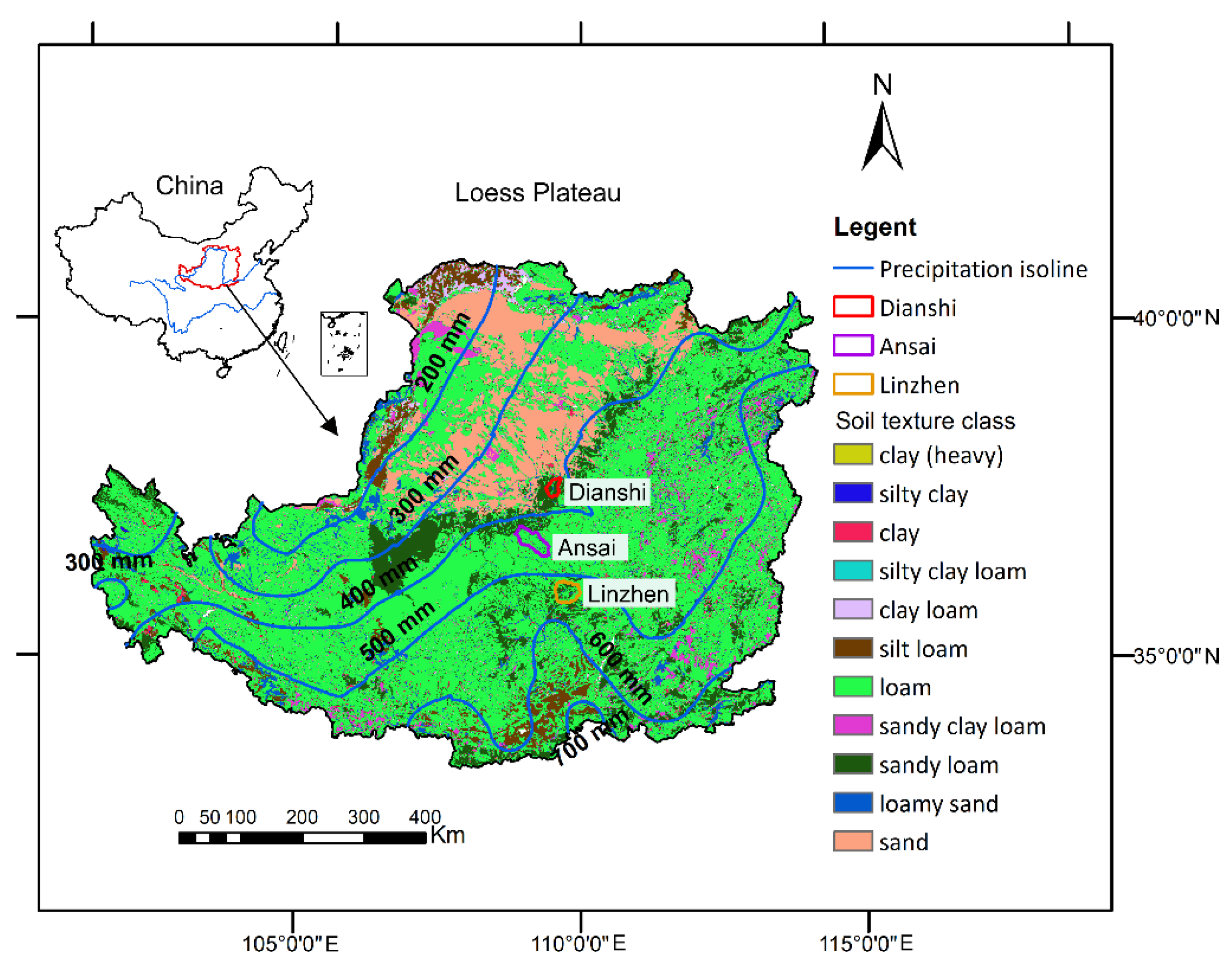
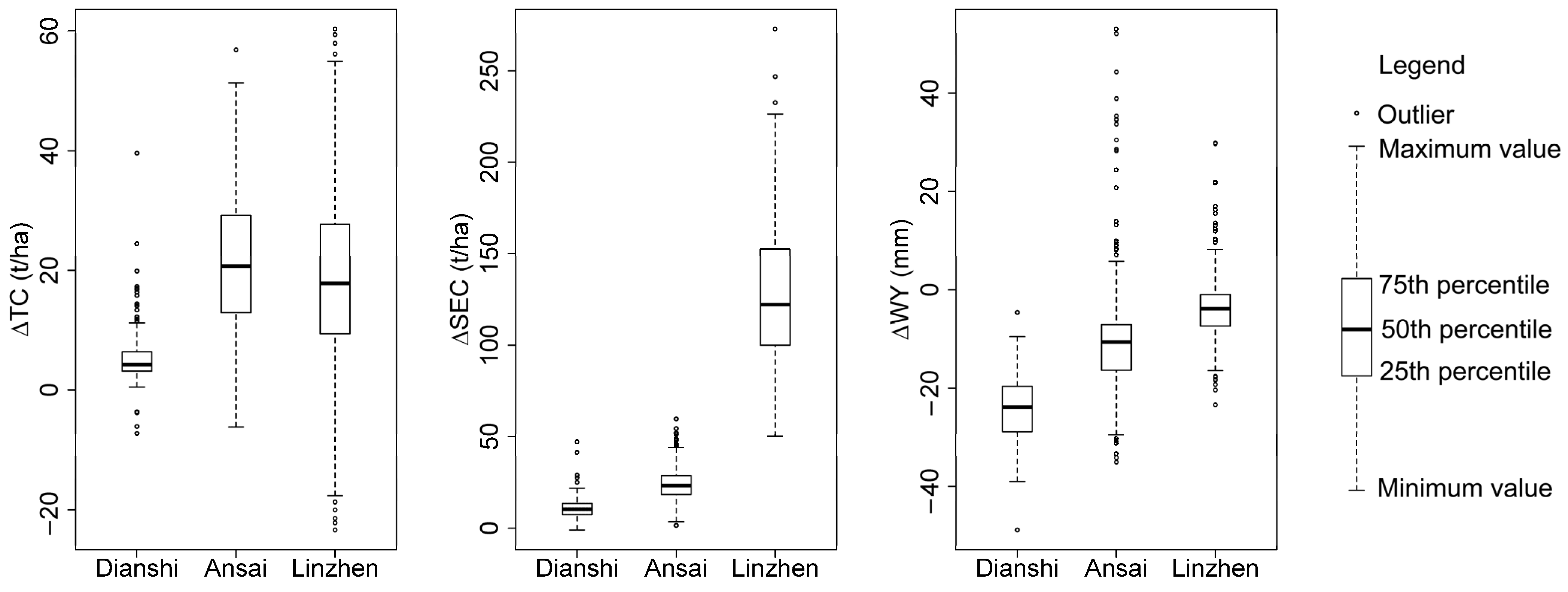
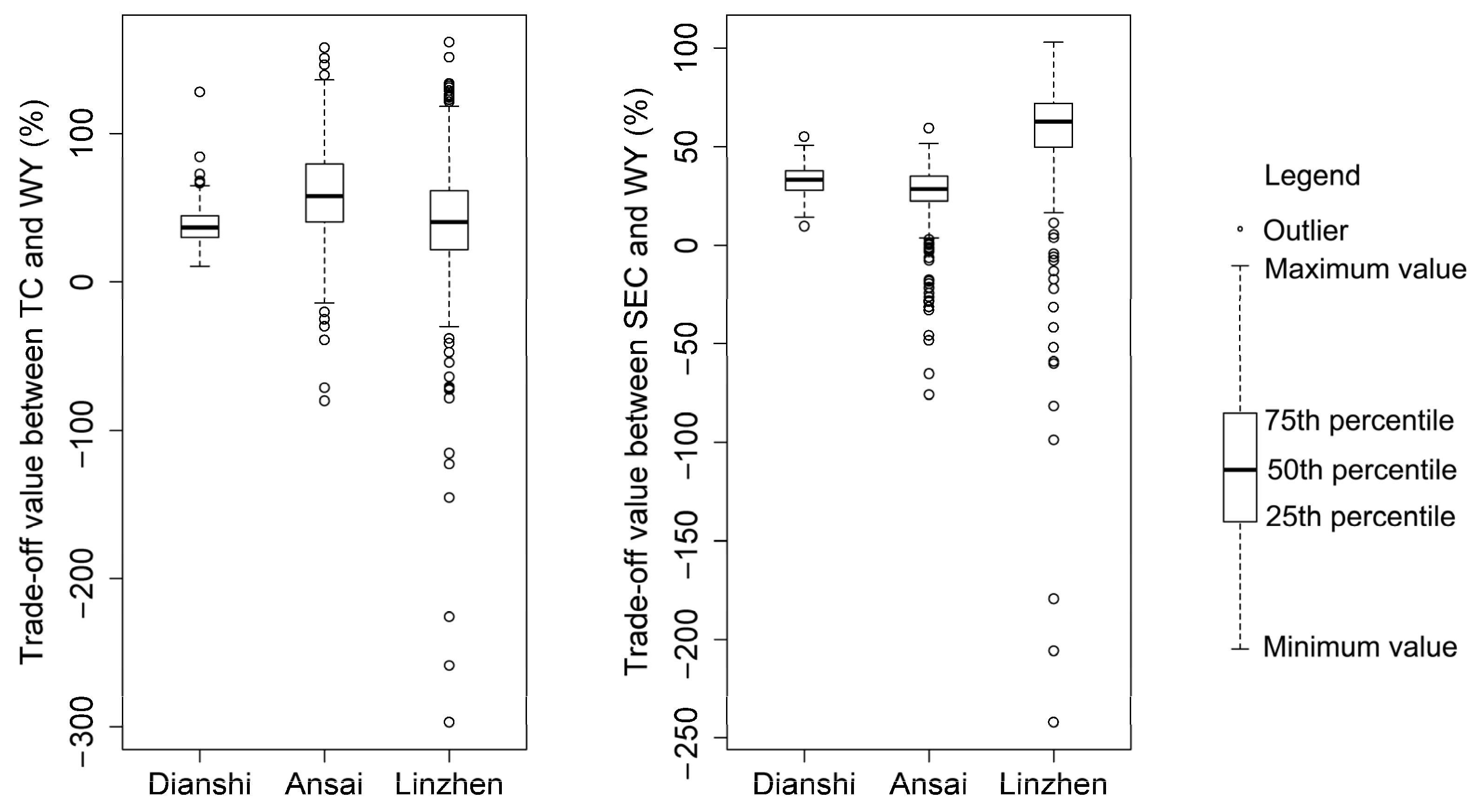
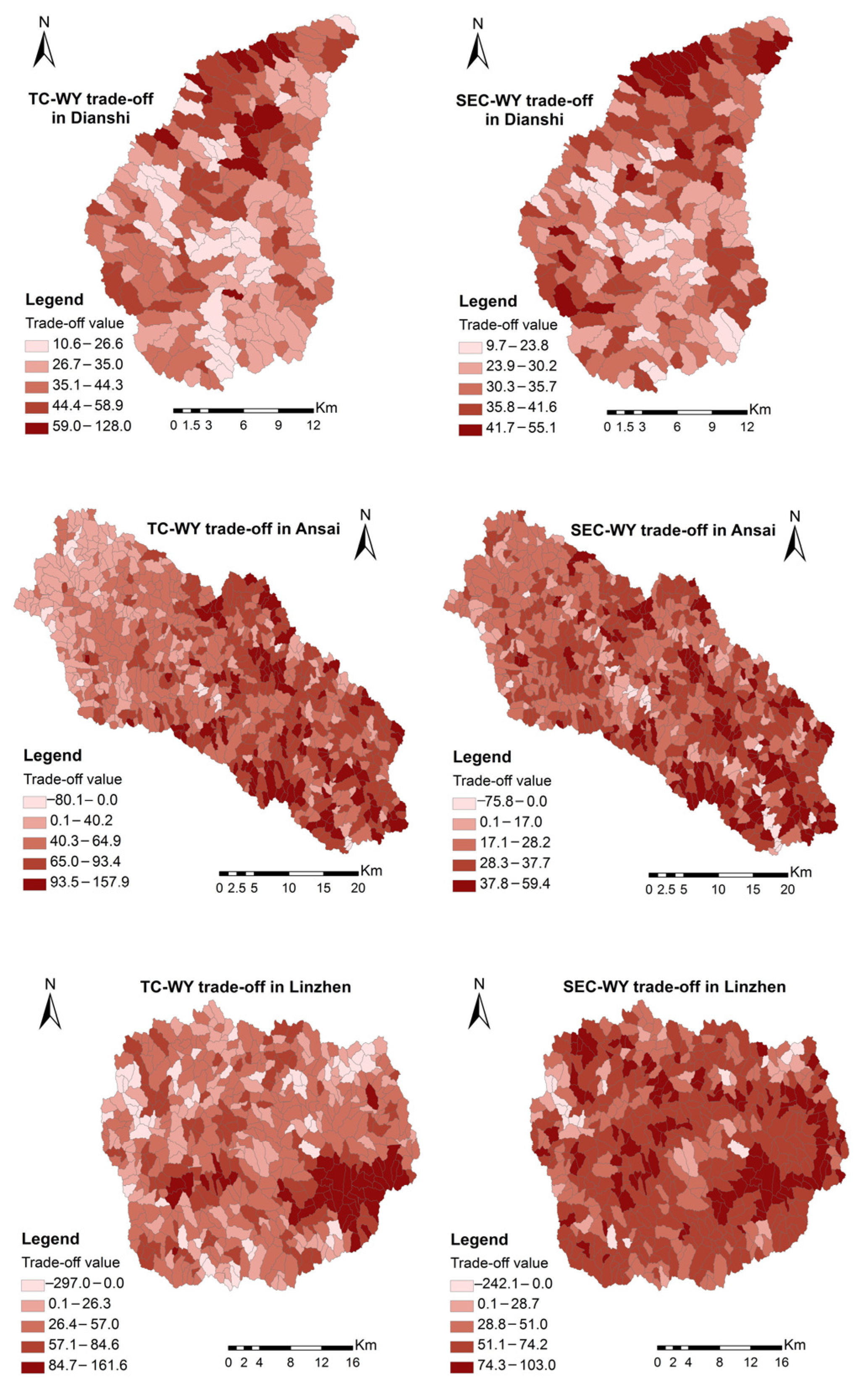
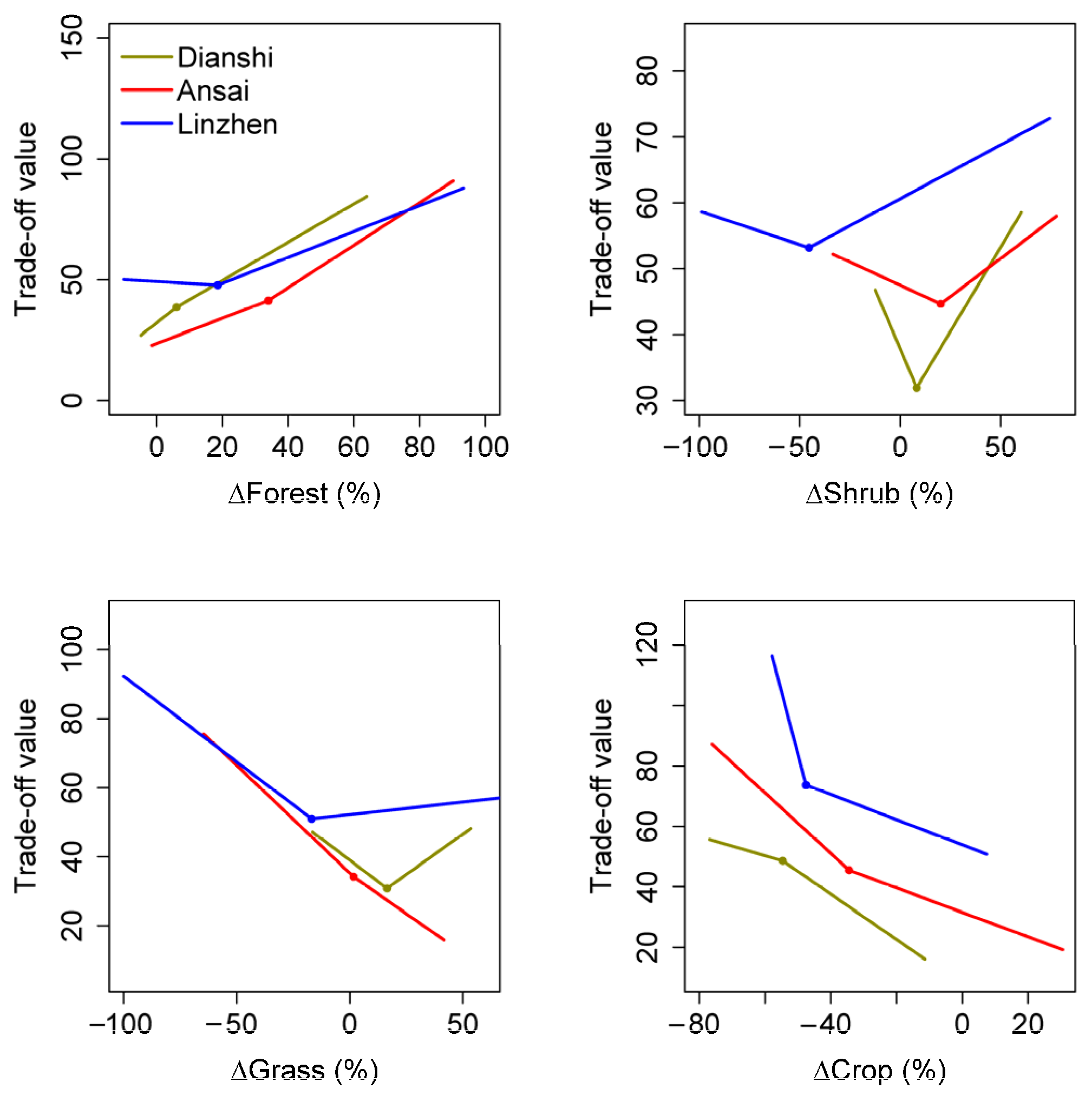
| FoL in 2018 | ShL in 2018 | GrA in 2018 | CrO in 2018 | CoL in 2018 | WaB in 2018 | Total in 2000 | ||
|---|---|---|---|---|---|---|---|---|
| Dianshi | FoL in 2000 | 0.11 | 0.09 | 0.41 | 0.04 | 0.01 | 0.00 | 0.66 |
| ShL in 2000 | 0.12 | 0.06 | 0.08 | 0.01 | 0.00 | 0.00 | 0.27 | |
| GrA in 2000 | 1.18 | 6.41 | 28.03 | 5.01 | 0.62 | 0.23 | 41.47 | |
| CrO in 2000 | 2.92 | 6.72 | 32.55 | 14.07 | 0.91 | 0.03 | 57.20 | |
| CoL in 2000 | 0.00 | 0.01 | 0.03 | 0.02 | 0.08 | 0.00 | 0.14 | |
| WaB in 2000 | 0.00 | 0.01 | 0.12 | 0.04 | 0.00 | 0.09 | 0.27 | |
| Total in 2018 | 4.34 | 13.29 | 61.22 | 19.19 | 1.62 | 0.35 | ||
| Change from 2000 to 2018 | 3.68 | 13.02 | 19.74 | −38.01 | 1.48 | 0.08 | ||
| Ansai | FoL in 2000 | 0.96 | 0.12 | 0.27 | 0.10 | 0.05 | 0.01 | 1.51 |
| ShL in 2000 | 0.59 | 0.21 | 0.54 | 0.09 | 0.03 | 0.00 | 1.46 | |
| GrA in 2000 | 20.01 | 6.97 | 22.89 | 3.63 | 1.07 | 0.25 | 54.82 | |
| CrO in 2000 | 17.36 | 5.46 | 13.09 | 4.82 | 1.26 | 0.04 | 42.03 | |
| CoL in 2000 | 0.04 | 0.00 | 0.01 | 0.04 | 0.07 | 0.00 | 0.16 | |
| WaB in 2000 | 0.01 | 0.00 | 0.01 | 0.00 | 0.00 | 0.00 | 0.03 | |
| Total in 2018 | 38.96 | 12.77 | 36.82 | 8.67 | 2.47 | 0.30 | ||
| Change from 2000 to 2018 | 37.45 | 11.31 | −18.00 | −33.35 | 2.31 | 0.27 | ||
| Linzhen | FoL in 2000 | 2.37 | 1.75 | 0.50 | 0.30 | 0.05 | 0.00 | 4.97 |
| ShL in 2000 | 23.35 | 12.44 | 7.14 | 4.34 | 0.89 | 0.01 | 48.18 | |
| GrA in 2000 | 10.10 | 9.55 | 2.97 | 1.91 | 0.40 | 0.08 | 25.02 | |
| CrO in 2000 | 4.75 | 3.43 | 5.45 | 6.78 | 1.07 | 0.14 | 21.61 | |
| CoL in 2000 | 0.00 | 0.02 | 0.01 | 0.03 | 0.03 | 0.00 | 0.09 | |
| WaB in 2000 | 0.00 | 0.01 | 0.01 | 0.09 | 0.00 | 0.02 | 0.12 | |
| Total in 2018 | 40.58 | 27.20 | 16.08 | 13.45 | 2.44 | 0.25 | ||
| Change from 2000 to 2018 | 35.61 | −20.98 | −8.94 | −8.16 | 2.35 | 0.13 |
| ∆ESs | Watershed | ∆Forest | ∆Shrub | ∆Grassland | ∆Cropland |
|---|---|---|---|---|---|
| ∆TC | Dianshi | 0.730 ** | 0.402 ** | −0.291 ** | −0.410 ** |
| Ansai | 0.922 ** | −0.167 ** | −0.723 ** | −0.262 ** | |
| Linzhen | 0.891 ** | −0.002 | −0.445 ** | −0.02 | |
| ∆SEC | Dianshi | −0.014 | 0.087 | 0.035 | −0.157 * |
| Ansai | 0.299 ** | 0.076* | −0.169 ** | −0.330 ** | |
| Linzhen | 0.196 ** | 0.237 ** | −0.351 ** | 0.063 | |
| ∆WY | Dianshi | −0.006 | −0.145 * | −0.527 ** | 0.852 ** |
| Ansai | −0.530 ** | −0.099 ** | 0.412 ** | 0.203 ** | |
| Linzhen | −0.082 | −0.276 ** | −0.023 | 0.917 ** |
| Land-Use | Quantile | TC–WY Trade-Offs | SEC–WY Trade-Offs | ||||
|---|---|---|---|---|---|---|---|
| Dianshi | Ansai | Linzhen | Dianshi | Ansai | Linzhen | ||
| Forest | 10th | 1.485 ** | 1.061 ** | 0.614 ** | 0.411 ** | 0.168 ** | 0.051 |
| 20th | 1.366 ** | 1.099 ** | 0.658 ** | 0.271 ** | 0.168 ** | 0.089 | |
| 30th | 1.378 ** | 1.173 ** | 0.648 ** | 0.296 ** | 0.225 ** | 0.126 ** | |
| 40th | 1.395 ** | 1.186 ** | 0.695 ** | 0.316 ** | 0.257 ** | 0.135 ** | |
| 50th | 1.453 ** | 1.213 ** | 0.724 ** | 0.263 ** | 0.254 ** | 0.092 ** | |
| 60th | 1.374 ** | 1.286 ** | 0.81 ** | 0.256 ** | 0.287 ** | 0.07 ** | |
| 70th | 1.411 ** | 1.316 ** | 0.816 ** | 0.307 ** | 0.284 ** | 0.045 | |
| 80th | 1.378 ** | 1.322 ** | 0.96 ** | 0.273 ** | 0.286 ** | 0.032 | |
| 90th | 1.309 ** | 1.296 ** | 1.125 ** | 0.232 * | 0.258 ** | 0.004 | |
| Shrub | 10th | 0.801 ** | 0.231 * | 0.016 | 0.362 ** | 0.282 ** | 0.083 ** |
| 20th | 0.687 ** | 0.041 | 0.024 | 0.3 ** | 0.211 ** | 0.078 ** | |
| 30th | 0.668 ** | −0.149 * | 0.017 | 0.273 ** | 0.213 ** | 0.086 ** | |
| 40th | 0.668 ** | −0.281 ** | 0.066 | 0.264 ** | 0.173 ** | 0.079 ** | |
| 50th | 0.644 ** | −0.313 ** | 0.082 * | 0.238 ** | 0.183 ** | 0.057 ** | |
| 60th | 0.6 ** | −0.327 * | 0.109 * | 0.186 ** | 0.183 ** | 0.055 ** | |
| 70th | 0.552 ** | −0.204 | 0.151 ** | 0.162 ** | 0.125 ** | 0.056 ** | |
| 80th | 0.455 ** | −0.179 | 0.235 ** | 0.151 | 0.12 * | 0.085 ** | |
| 90th | 0.284 | 0.009 | 0.376 ** | 0.185 | 0.183 ** | 0.095 ** | |
| Grassland | 10th | 0.282 ** | −0.716 ** | −0.227 ** | 0.441 ** | −0.09 ** | −0.12 ** |
| 20th | 0.221 ** | −0.86 ** | −0.287 ** | 0.382 ** | −0.118 ** | −0.072 ** | |
| 30th | 0.194 * | −0.942 ** | −0.295 ** | 0.324 ** | −0.171 ** | −0.046 | |
| 40th | 0.081 | −1.004 ** | −0.308 ** | 0.286 ** | −0.199 ** | −0.046 | |
| 50th | 0.009 | −1.038 ** | −0.343 ** | 0.251 ** | −0.222 ** | −0.034 | |
| 60th | −0.04 | −1.075 ** | −0.331 ** | 0.175 ** | −0.228 ** | −0.024 | |
| 70th | −0.152 | −1.125 ** | −0.381 ** | 0.139 * | −0.268 ** | −0.017 | |
| 80th | −0.155 | −1.152 ** | −0.454 ** | 0.112 * | −0.265 ** | −0.014 | |
| 90th | −0.158 | −1.185 ** | −0.511 ** | 0.125 * | −0.297 ** | −0.035 * | |
| Cropland | 10th | −0.837 ** | −0.561 ** | −0.493 ** | −0.637 ** | −0.256 ** | −0.726 ** |
| 20th | −0.742 ** | −0.719 ** | −0.344 ** | −0.59 ** | −0.308 ** | −0.667 ** | |
| 30th | −0.717 ** | −0.789 ** | −0.302 ** | −0.613 ** | −0.35 ** | −0.664 ** | |
| 40th | −0.738 ** | −0.887 ** | −0.317 ** | −0.621 ** | −0.353 ** | −0.644 ** | |
| 50th | −0.753 ** | −0.955 ** | −0.317 ** | −0.609 ** | −0.362 ** | −0.564 ** | |
| 60th | −0.735 ** | −0.983 ** | −0.281 * | −0.581 ** | −0.403 ** | −0.574 ** | |
| 70th | −0.724 ** | −1.047 ** | −0.17 | −0.553 ** | −0.403 ** | −0.551 ** | |
| 80th | −0.791 ** | −1.084 ** | −0.114 | −0.538 ** | −0.373 ** | −0.536 ** | |
| 90th | −0.866 ** | −1.207 ** | −0.164 | −0.476 ** | −0.361 ** | −0.569 ** | |
| Dianshi Watershed | Ansai Watershed | Linzhen Watershed | |||||||||
|---|---|---|---|---|---|---|---|---|---|---|---|
| LUT | Marg | LUT | Cond | LUT | Marg | LUT | Cond | LUT | Marg | LUT | Cond |
| LCrO-FoL | 43.1 | LCRO-FOL | 43.1 | LCRO-FOL | 45.9 | LCRO-FOL | 45.9 | LShL-CrO | 43.4 | LShL-CrO | 43.4 |
| LGrA-FoL | 36.2 | LGrA-CrO | 22.6 | LGrA-FoL | 43.7 | LCrO-CoL | 19.7 | LFoL-CrO | 35.3 | LFoL-CrO | 14.5 |
| LGrA-CrO | 34.3 | LCrO-ShL | 9.6 | LGrA-GrA | 20.3 | LGrA-FoL | 7.5 | LGrA-FoL | 22.6 | LGrA-FoL | 10.8 |
| LCrO-CrO | 28.2 | LCrO-GrA | 7.1 | LCrO-GrA | 19.1 | LGrA-ShL | 7.3 | LCRO-FOL | 6.6 | LCRO-FOL | 11.3 |
| LCrO-ShL | 12.6 | LCrO-CoL | 12.1 | LGrA-CoL | 5.5 | LGrA-ShL | 6.6 | ||||
| LGrA-CoL | 7.9 | LGrA-CoL | 9.9 | ||||||||
| LCrO-CoL | 6.3 | LShL-GrA | 5.9 | ||||||||
| LGrA-GrA | 5.0 | ||||||||||
Publisher’s Note: MDPI stays neutral with regard to jurisdictional claims in published maps and institutional affiliations. |
© 2021 by the authors. Licensee MDPI, Basel, Switzerland. This article is an open access article distributed under the terms and conditions of the Creative Commons Attribution (CC BY) license (https://creativecommons.org/licenses/by/4.0/).
Share and Cite
Feng, Q.; Dong, S.; Duan, B. The Effects of Land-Use Change/Conversion on Trade-Offs of Ecosystem Services in Three Precipitation Zones. Sustainability 2021, 13, 13306. https://doi.org/10.3390/su132313306
Feng Q, Dong S, Duan B. The Effects of Land-Use Change/Conversion on Trade-Offs of Ecosystem Services in Three Precipitation Zones. Sustainability. 2021; 13(23):13306. https://doi.org/10.3390/su132313306
Chicago/Turabian StyleFeng, Qiang, Siyan Dong, and Baoling Duan. 2021. "The Effects of Land-Use Change/Conversion on Trade-Offs of Ecosystem Services in Three Precipitation Zones" Sustainability 13, no. 23: 13306. https://doi.org/10.3390/su132313306
APA StyleFeng, Q., Dong, S., & Duan, B. (2021). The Effects of Land-Use Change/Conversion on Trade-Offs of Ecosystem Services in Three Precipitation Zones. Sustainability, 13(23), 13306. https://doi.org/10.3390/su132313306






